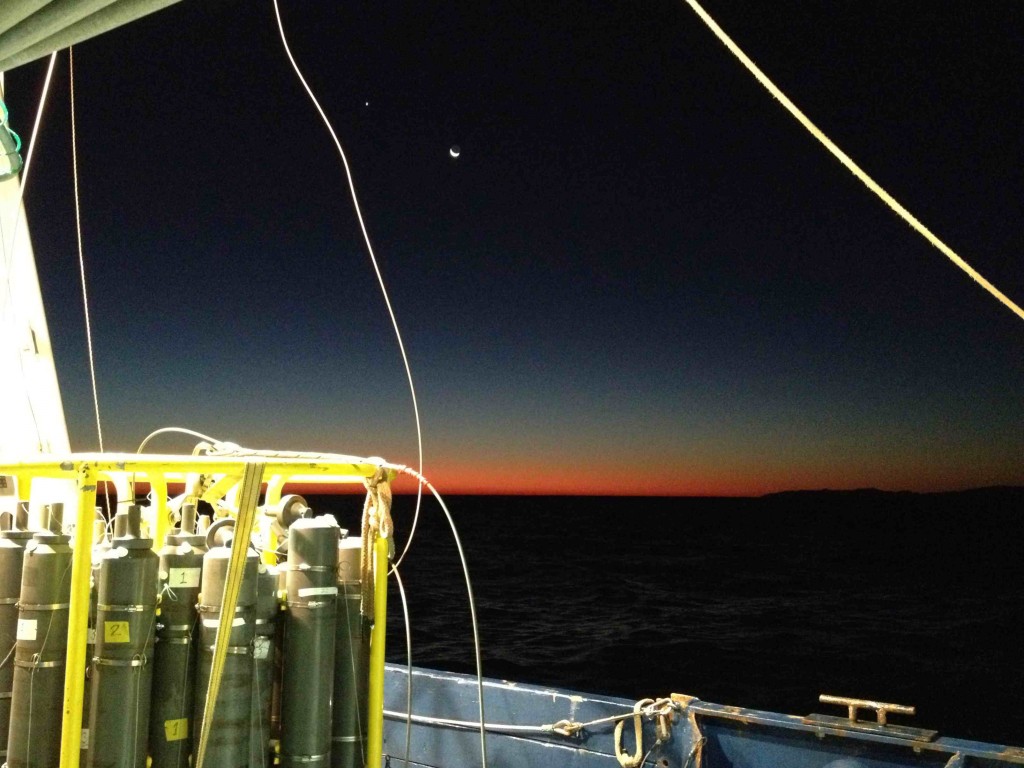In the main lab on the New Horizon is nested the brain center of deck operations. Several monitors hover above a desk spouting various information streams: ship location, speed, ETA, time to station, information on currents, the output from the CTD, the depth of the water based on the several sources, the amount of cable out on the various winches, and a monitor with cc tv on four separate deck cameras. There are other instruments here too, such as specialized computers for controlling the MOCNESS and any other specific equipment brought on for a given group. It is the job of the chief scientist, or the res tech, (or whomever’s experiment it happens to be at the time) to sit in this location to monitor and even control certain aspects of the operation. Importantly, there is an open line to the winch operator and bridge. Throughout a deployment, many commands are called out and affirmed. Questions are asked and answered. Occasionally, late into a shift, the odd joke might be told to keep everyone awake. The command center is thus the hub of all communication- between humans and machines, and humans and other humans- all over the ship.
Author Archives: jozenn
Filtering in the wet lab
I know you will have read the scientist’s statements by now (wink wink, nudge nudge), and thus be completely up to date on what we are all trying to do and how. Ben Temperton and I are utilizing the same samples to accomplish different goals. The bulk of our work from metagenomics and single-cell genomics will come much later, after we sequence the DNA from our filters and our isolated cells. Our ship time is thankfully pretty straightforward, by design. While the ship has traveled all around the Southern California bight to serve the varied needs of the science team, we are taking samples specifically along a coastal to deep-water transect using sites from the CalCOFI surveys to improve our metadata.
Our ideas for this sampling opportunity started in the same way as many, literally sketched out on a piece of paper, which turned into a proposal, and has landed us here on the ship, carrying out the work. An amazing opportunity, to be sure. Our sampling plan is simple: take several discrete water samples using the CTD from each site, filter some of the water for later DNA extraction and metagenomic sequencing, concentrate cells from the remaining water for later cell-sorting and single-cell genome amplification/sequencing. Because we’re filtering large volumes of water, we’re in the wet lab. Most ships have one- a place usually near a deck where water can get spilled and it’s not the end of the world. Ours is set up for use with 142mm filter units and a small tangental flow filtration system. After filtering, everything goes in a liquid N2 dewar to keep it cold. Simple enough. For now. Post-sequencing, the workload explodes.
Working the night watch
It is not unusual for oceanographic research cruises to have a watch schedule. This cruise is no exception. We have two watches, noon to midnight and midnight to noon. Yours truly, Cameron Thrash, is on the night watch. It’s a crazy thing to try and adapt to. Yesterday, being the first day, I didn’t sleep much. We started with CTD casts, multi-corer casts, bongo net casts, MOCNESS casts and just went all through the night (more on these later). It was a productive time. I got off watch at noon, took a shower, did some laundry, and promptly slept for several hours. I got up at 9pm for what is now my morning before work! Ben saved me a dinner plate of lamb and prime rib. Breakfast of champions. Now, we’re at it again, working under the stars. There are several good things about working the night watch- you get to have coffee all night long, and the sunrises are gorgeous.
Posts coming…
The participants of the workshop will be posting here. Stay tuned! We’re less than a week away.





